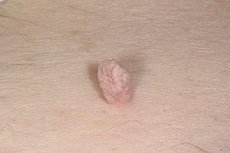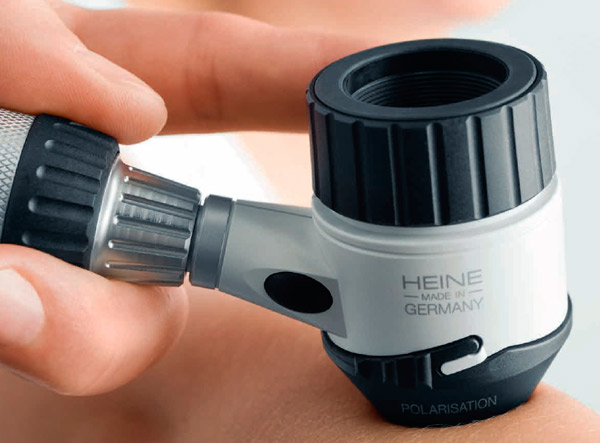Medical expert of the article
New publications
Hanging moles
Last reviewed: 04.07.2025

All iLive content is medically reviewed or fact checked to ensure as much factual accuracy as possible.
We have strict sourcing guidelines and only link to reputable media sites, academic research institutions and, whenever possible, medically peer reviewed studies. Note that the numbers in parentheses ([1], [2], etc.) are clickable links to these studies.
If you feel that any of our content is inaccurate, out-of-date, or otherwise questionable, please select it and press Ctrl + Enter.

Every person has moles – some have more, some have less. They appear in the first months of a child’s life and remain for life. Some nations consider the presence of many moles on the body to be a sign of a long, happy and comfortable life. In the Middle Ages, fashionistas and beauties even painted “flies” on their faces to look more flirtatious and charming. However, not all moles are so harmless. The medical name for moles is nevus, and they are considered a congenital or acquired skin defect. As a rule, moles are a small, brown, slightly convex spot – this is how we are used to seeing them. However, there are also other varieties. For example, hanging moles. Their peculiarity is that they develop from epithelial tissue. They are a cone-shaped growth with an uneven surface. As a rule, their color does not differ from the color of the skin, but they can be in a variety of colors – from white to dark brown. Hanging moles “like” to settle on the neck, under the arms, in the groin.
 [ 1 ]
[ 1 ]
Causes hanging mole
The reasons for the appearance of hanging moles on the body are varied and are individual for each individual.
One of the reasons is a change in the body's hormonal background. For example, this is a common occurrence in pregnant women. Women notice that small formations - hanging moles - begin to grow under their arms or in the groin. Such nevi are not dangerous, and sometimes even remain completely unnoticed. They disappear after childbirth, as soon as the woman's hormonal background returns to normal.
The second reason is the human papilloma virus. In this case, everything is much more serious. The virus gets into the blood and multiplies, causing multiple lesions to appear on the skin. If there is a suspicion of infection with the papilloma virus, the attending physician will send you for tests, the results of which will help to choose further treatment.
The third reason is age-related changes in the skin and hormonal background. This theory was put forward by American doctors, and so far it has not been able to be either fully confirmed or refuted. However, it is known for certain that cases of hanging moles appearing in elderly people are very common.
And fourthly, the effect of ultraviolet radiation on the skin. It has long been noted that areas of the skin that are often exposed to sunlight are prone to the formation of nevi. It is better to cover up moles on exposed parts of the body or treat the skin with products with a UV filter.
Pathogenesis
The causes and mechanism of the appearance of hanging moles on the body have not yet been fully studied. However, it is known for sure that they most often appear in places that are subject to friction or exposure to ultraviolet radiation. For some reason, epithelial cells begin to divide with double force, which leads to the mole increasing in size and acquiring the appearance of a small cone-shaped formation of irregular shape.
Symptoms hanging mole
The symptoms of hanging moles are very simple and obvious. When palpated, a nipple-shaped formation is felt, painless when touched. This is a hanging mole. As a rule, several days pass before a person or one of his relatives pays attention to the neoplasm, especially if the hanging mole is on the back, shoulders or in the pelvic area, where it is not easy to notice. If the mole was damaged, then minor bleeding, a burning sensation, pain are possible. Later, the location of the mole may swell, change color, which in itself is a formidable symptom. In such a case, you must immediately consult a doctor.
 [ 5 ]
[ 5 ]
Are hanging moles dangerous?
Single moles of this type are a common occurrence. However, if moles begin to appear in large numbers, hurt, itch, or change color in any way, this is a reason to see a doctor. Doctors consider moles of this type to be potentially dangerous and advise paying close attention to them. It is necessary to ensure that such moles do not develop into tumor-like formations. There is no point in panicking, because many people live with hanging moles all their lives without any particular problems. However, it is worth listening to your doctor and doing all the necessary skin tests and tests. The danger is that hanging moles can often be injured by clothing or accessories, and on open areas of the body they are exposed to ultraviolet radiation. If you tear off such a mole, this can provoke suppuration or even the appearance of melanoma. If the nevus is damaged, it is recommended to cauterize the wound with a disinfectant - for example, hydrogen peroxide or iodine.
Forms
Hanging moles vary in appearance and location.
They can have uneven, bumpy edges or be smoother in shape, resembling a pea.
The color also varies – from white to dark brown and even black.
Depending on their location, hanging moles are divided into those that form in the groin, under the arms, on the face and on the neck. They are most often found in these places. Black hanging moles are not very good in themselves. After all, nevi turn black due to damage or inflammation. If you find that a hanging mole has turned black, do not hesitate, go to the clinic for tests. White hanging moles are most often found during puberty and in pregnant women - under the arms or in the groin. They are dangerous because they can easily go unnoticed and be cut off during hygiene procedures. If this happens, quickly treat the wound with a disinfectant. Large brown hanging moles appear on the face and neck, they also cause a lot of inconvenience to a person - from their appearance to constant injury from clothing.
It is better to remove a hanging mole on the neck, as it is constantly exposed to ultraviolet radiation and rubs against clothing - a collar or scarf. Hanging moles on the face are especially inconvenient for women, because such a formation will not decorate even the prettiest face.
Hanging moles under the armpits are most often injured during bathing or shaving. If you constantly accidentally cut a mole, it is better to remove it, since systematic damage can cause it to grow or become infected.
If a mole is inflamed, itchy, or painful, this is the first sign that inflammatory processes are occurring in it, which can have the most negative impact on the body. Therefore, at the slightest change in the appearance of moles, or painful sensations in them, go to the doctor immediately! The same should be done if a hanging mole is covered with a crust, has become denser, or the vascular pattern on it has changed.
If a hanging mole turns red and hurts, there may be several reasons for this: the same hormonal imbalances (in teenagers, pregnant women and women on certain days of the cycle); accidental cuts or rubbing with clothing; and, finally, the most serious reason - the degeneration of a mole from a benign formation into a malignant one. Such transformations may be accompanied by the appearance of blood inside the mole, its loosening, a radical change in color. Of course, the feeling of pain will not be as strong as, for example, with a gumboil, but it is difficult not to notice it.
 [ 8 ]
[ 8 ]
Diagnostics hanging mole
Diagnosis of hanging moles does not present any difficulty for an experienced doctor. The characteristic shape, location and color of these skin formations speak for themselves.

In cases where there is a suspicion that the formation is not benign, a biopsy will be suggested to determine the nature of the mole.
Also, for diagnostic purposes, tests are conducted for the presence of the human papilloma virus. In this case, local treatment of hanging moles will be ineffective.
If a mole has changed in size or turned black, an examination should be carried out by an oncologist.
Treatment hanging mole
There are many methods to get rid of hanging moles, from radical removal to treatment with various folk remedies.
- At home, hanging moles can be smeared with iodine solution or celandine tincture. The latter, however, should be used very carefully, as burns are possible. The tincture should be applied pointwise directly to the nevus.
- Large moles that spoil the appearance and are in the way are best removed. Of course, this should be done after consulting a dermatologist. Removal of hanging moles on the neck, face or body is carried out in a clinic or cosmetology room.
Removal is possible by cauterization with liquid nitrogen (the most effective method 85-100%), laser (electrocoagulation) or by surgical intervention under local anesthesia. The latter method is the most traumatic, and is currently rarely used. A laser will cope with the task much better than a scalpel.
- If the appearance of hanging moles is associated with the papilloma virus, then the following drugs can be used: Condimin, Bonafton ointment, Aldora cream. They are based on folk recipes using medicinal herbs. These ointments are applied to the mole twice a day for two weeks. Contraindications to treatment are pregnancy and lactation. Recently, the drug Panavir has appeared, which is administered intravenously and destroys the papilloma virus. However, it also cannot be used during pregnancy and in children under 12 years of age. Adults with papillomavirus infection are usually prescribed 5 ml of solution every 48 hours, after 3 injections, they switch to 5 ml of Panavir solution every 72 hours. The course of treatment is 5 injections.
- Folk methods, such as compresses with Kalanchoe juice, garlic, potatoes and celandine are not very effective, but they can also be used. Some recipes recommend removing small hanging moles with vinegar essence. We would like to warn you against such extremes - as a result of such "treatment" a serious chemical burn may form, which you will have to treat for a very long time.
The simplest folk method is to tie the base of a hanging mole with a coarse thread. Dermatologists do not recommend using this type of removal - firstly, it is unhygienic, and secondly, it is ineffective.
A popular remedy is wormwood oil for hanging moles. It is recommended to lubricate it with wormwood essential oil twice a day for several weeks. After such treatment, they disappear.
Many people are interested in the question of how to remove hanging moles around the eyes and whether it is dangerous. It is recommended to remove such moles surgically with the application of a thin cosmetic suture. Laser or liquid nitrogen may leave marks on the skin of the face.
Treatment of hanging moles should be comprehensive, taking into account the anamnesis in each specific case. During pregnancy, it is better not to remove hanging moles. It is better to wait until the hormonal balance is restored. And of course, in no case should you tear off or cut off hanging moles! This can lead to the most unpleasant consequences. If this happened by accident, the wound should be cauterized with iodine or peroxide, and consult a doctor.

